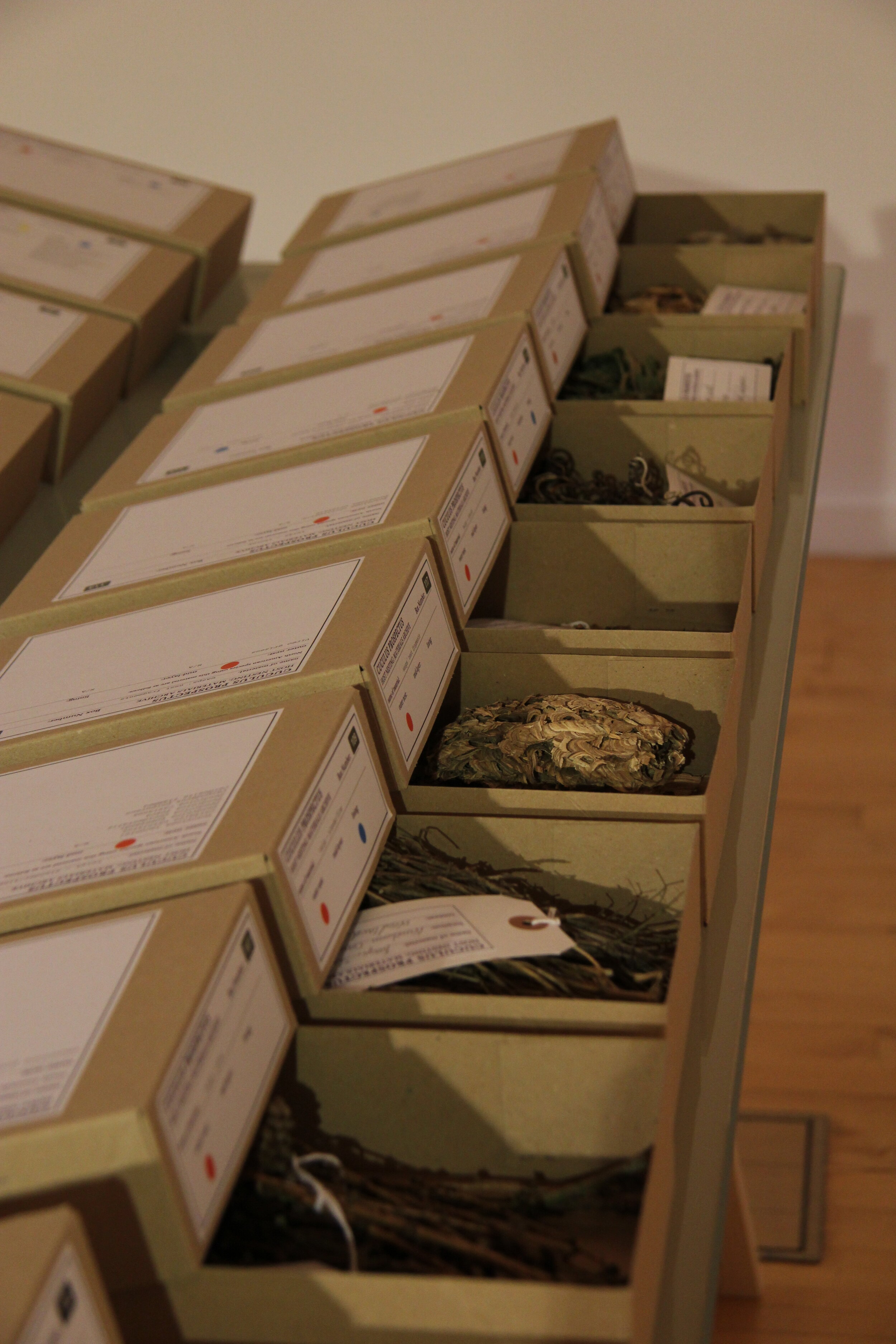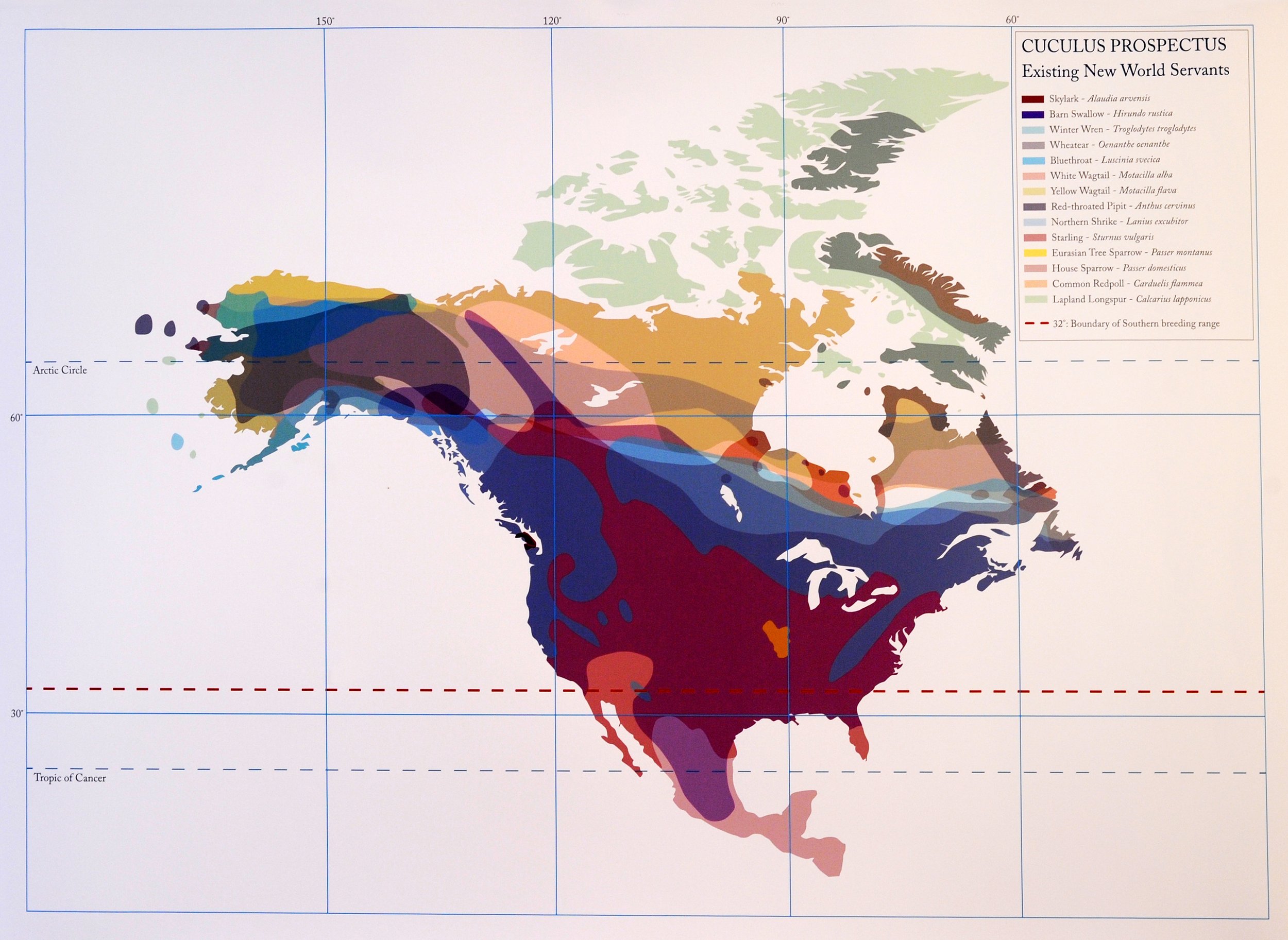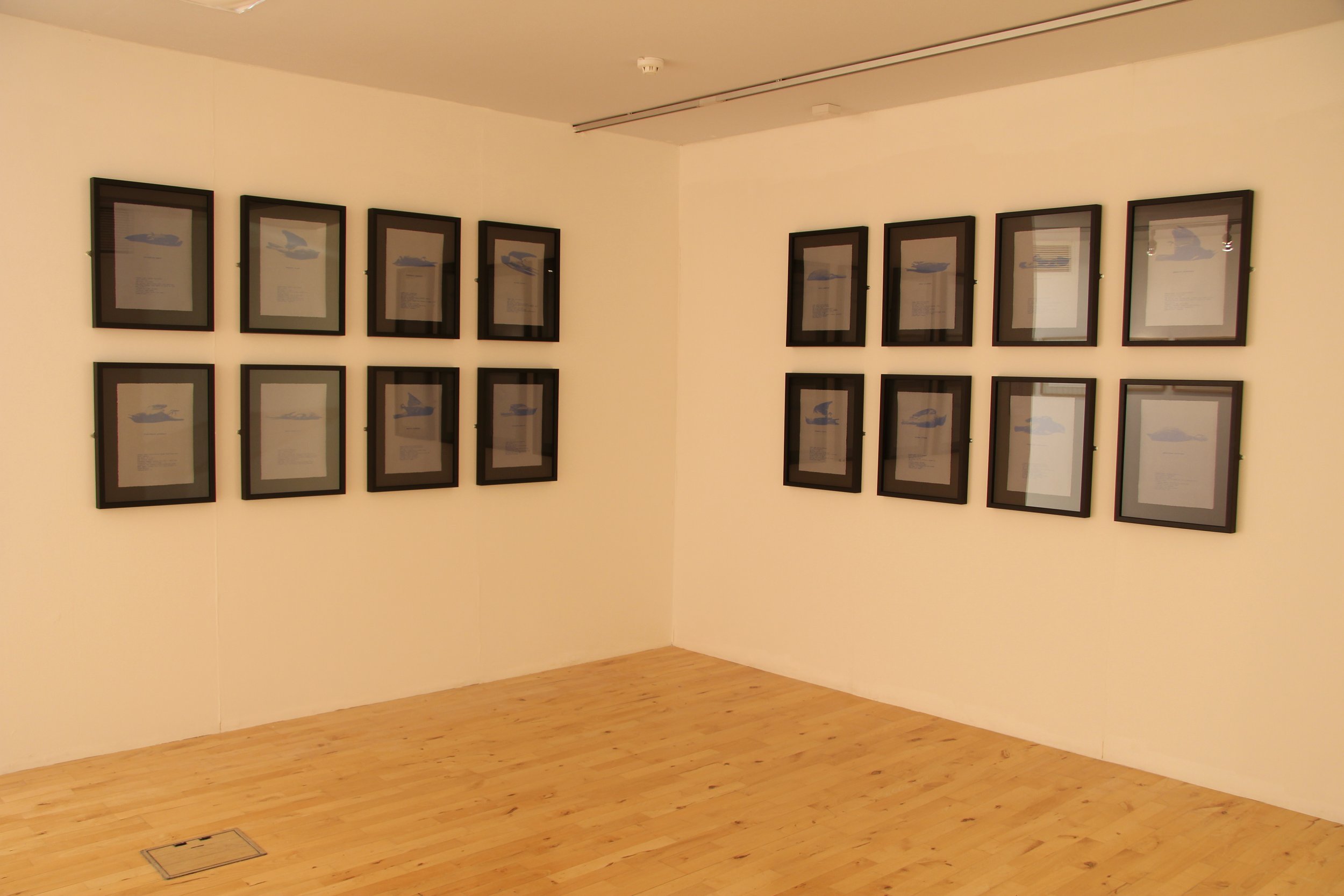
Cuculus Prospectus
Cuculus Prospectus 2011
About the project:
Cuculus Prospectus comprised sculptures, prints, drawings, photographs and video, and was shown in a series of exhibitions in UK galleries, museums and alternative venues between 2011 and 2013. The result of an extended period of practice-led academic research, this work utilises the parasitic habits of the Eurasian Cuckoo Cuculus canorus, as a metaphor for and means to understand human and animal colonialism, migration and shifting global ecologies.
Building on earlier works How to Speak…: The Breeding Birds of the United Kingdom, 2000, and Briefe and True: Lost Landscapes 2005, Cuculus Prospectus expands imaginatively Thomas Harriot's 1590 ‘A Briefe and True Report of the New Found Land of Virginia’ (partially designed as a ‘prospectus’ for English colonists). It included descriptions of resources - plant, animal, mineral & human - of modern coastal North Carolina, USA. Cuculus Prospectus expands on these Early Modern ideas, with reference to natural history, taxonomy, animal/human migration and global environmental change. In this exhibition, the fascinating behaviours of Cuculus canorus - including the use of 'brood parasitism' to reproduce – are explored through differing works in a wide range of media. In researching this work, I attempted to simultaneously think and act like both human and Cuckoo. This conjunction produced a strange logic through which various individual works emerged. Methods I have referred to as ‘pseudoscientific’ were used to make decisions and organise information forming the basis of the works that make up Cuculus Prospectus. Through these, audiences may learn a great deal about Cuculus canorus, though the work is as much about our (human) selves.
Cuculus canorus is found in Europe, Asia and Africa but nowhere in the Americas. Whilst this project explores a potential event that is technically and biologically unlikely Cuculus Prospectus invites questions about Europe's colonial past, imagining a scenario in which an ‘Old World’ bird plans the extension of its breeding territory into another ‘new’ continent. The work refers to the extents to which human actions have affected plant and animal life on earth - species whose habitats/ranges are extending, shifting and diminishing. The effects of colonialism on global, biological environments, are what Alfred Crosby has referred to as 'Ecological Imperialism' (Cambridge, 1986).
For this project, I utilised resources from the ornithological archives at the Natural History Museum, London (Tring), Oxford University Museums and the Alexander Library Oxford.
Works:
Cuculus Prospectus: Nesting Materials Archive
2011
Media: wood, glass, cardboard and mixed media
Size: 2600 x 3000 x 850mm
Exhibited:
2013 – SOLO (one-person exhibition) Cuculus Prospectus, Waterfront Gallery, UCS, and Ipswich Museum, Suffolk.
2012 – OVADA Spotlight (group exhibition) Oxford Town Hall (Panel Room and Court Room).
2011 – Cuculus Prospectus (one-person exhibition), Beldam Gallery, Brunel University.
About this work:
Cuculus Prospectus: Nesting Materials Archive is an equivalent to an empirically correct cataloguing system. It explicitly refers to historic conventions of collecting, organising and archiving information and specimens from nature. Each of the 125 boxes contains a material used by the 160 potential North American ‘cuckoo hosts’ for nest construction. The alphabetized archive separates materials used for outer, mid-layer and inner nest construction as described in ornithological field guides/handbooks. Box labels and accompanying wall charts enable viewers to cross-reference materials to species (and vice versa) and to imagine each host’s nest from the perspective of a non-nesting human/cuckoo.
Cuculus Prospectus (Ruff-book)
2011
Media: laser-cut fabric, bookbinding materials
Size: 55 x 55 x 25cm
Cuculus Europaeus (Ruff-book)
2011
Media: laser-cut fabric, bookbinding materials
Size: 55 x 55 x 20cm
Bibliotheca (Ruff-book Library)
2011
Media: laser-cut fabric, bookbinding materials
Size: 125mm x variable dimensions – (12 small books)
Exhibited:
2013 – Unruly Objects (one-person exhibition), Cornerstone Gallery and Arts Centre, Didcot, Oxfordshire.
2013 – SOLO (one-person exhibition) Cuculus Prospectus, Waterfront Gallery, UCS, and Ipswich Museum, Suffolk.
2011 – Cuculus Prospectus (one-person exhibition), Beldam Gallery, Brunel University.
About this work:
Cuculus Prospectus and Cuculus Europaeus hybridise the combined forms of the book and the neck ruff—a popular late 16th century garment with its own specific symbolic references. The ‘books’ contain the laser-cut Latin names (in taxonomical order) of the 160 North American bird species capable of acting as host to Cuculus canorus, and the 107 documented European host species. In Bibliotheca the contents of CP are separated into 12 volumes representing taxonomical groupings or families of New World hosts.
Those Who Have Served
2011
Media: oak, plywood, vinyl text
Size: 1200 x 910mm (x 4)
Exhibited:
2013 – Unruly Objects (one-person exhibition), Cornerstone Gallery and Arts Centre, Didcot, Oxfordshire.
2013 – SOLO (one-person exhibition) Cuculus Prospectus, Waterfront Gallery, UCS, and Ipswich Museum, Suffolk.
2012 - OVADA Spotlight (group exhibition) Oxford Town Hall (Panel Room and Court Room).
2011 – Cuculus Prospectus (one-person exhibition), Beldam Gallery, Brunel University.
About this work:
Those Who Have Served is made from oak with gold text, and uses conventions of war memorials and institutional displays rewarding human achievement or membership. Instead, these panels list common bird names, indicating the European species whose nests have been found to contain cuckoo eggs and therefore to have ‘served’ the brood parasite. Compiled from a range of sources, it is made up of both rare and common hosts as well as anomalies with explicit reference made to species known to have fledged young cuckoos.
Enemy # 1 and Enemy # 2
2011
Media: graphite on paper,
Size: 900 x 700mm,
Exhibited:
2013 – Unruly Objects (one person exhibition), Cornerstone Gallery and Arts Centre, Didcot, Oxfordshire.
2013 – SOLO (one person exhibition) Cuculus Prospectus, Waterfront Gallery, UCS, and Ipswich Museum, Suffolk.
2011 – Cuculus Prospectus (one person exhibition), Beldam Gallery, Brunel University.
About this work:
Enemy #1 and Enemy #2 are drawings of Brown-headed and Bronzed Cowbirds, which are native to North America. Like Cuculus canorus, they are also brood parasites. Cowbirds lay their eggs in the nests of many other bird species. Unlike Eurasian cuckoos, who eject the eggs and young of their host parents and are raised as singleton chicks, cowbirds do not use egg mimicry and their young often co-habit with those of their hosts. Although no other parasitic cuckoo species live in North America, for the fictitious Cuculus Prospectus, cowbirds represent competition in the pursuit of New World hosts.
Existing New World Servants
2011
Media: inkjet print on paper,
Size: 750 x 600mm, 2013 – Unruly Objects (one person exhibition), Cornerstone Gallery and Arts Centre, Didcot, Oxfordshire.
Exhibited:
2013 – SOLO (one person exhibition) Cuculus Prospectus, Waterfront Gallery, UCS, and Ipswich Museum, Suffolk.
2012 – The Fools Journey (group exhibition) Curious Matter (NJ) and Proteus Gowanus (Brooklyn NY) USA.
2011 – Cuculus Prospectus (one person exhibition), Beldam Gallery, Brunel University.
New World Kin
2011
Media: inkjet print on paper
Size: 750 x 600mm
Exhibited:
2013 – Unruly Objects (one person exhibition), Cornerstone Gallery and Arts Centre, Didcot, Oxfordshire.
2013 – SOLO (one person exhibition) Cuculus Prospectus, Waterfront Gallery, UCS, and Ipswich Museum, Suffolk.
2011 – Cuculus Prospectus (one person exhibition), Beldam Gallery, Brunel University.
About this work:
Existing New World Servants overlays distribution diagrams of the North American territories of 14 European host species, common to both ‘Old’ and ‘New World’. New World Kin is made up of the distribution maps of 2 non-parasitic North American cuckoos. Although both works resemble recognisable land maps, they contain no physical geographical information.
New World Birdlife
2011
Media: sugar paper exposed to sunlight
Size: 400 x 500mm (x16)
Exhibited:
2011 – Cuculus Prospectus (one person exhibition), Beldam Gallery, Brunel University.
About this work:
New World Birdlife was made by ‘burning’ images—using sunlight—into low-grade sugar paper, exploiting its natural photosensitivity. These images are displayed in low-light conditions in order to prolong their life. In time they may fade, disappearing altogether. Sugar paper is named after the poor quality paper used to wrap sugar loaves imported from the New World during the Atlantic slave trade. Images for this work were sourced from William E. D. Scott, Bird Studies: An Account of the Land Birds of Eastern North America, in the Alexander Ornithology Library in Oxford. Most images in the book are of dead birds, prompting further connections to Jean-Jacques Audubon and his contemporaries, whose pre-photographic wildlife illustrations were made using dead specimens—hunted and killed for the specific purpose of image making. This is a reminder that we do not have to look too hard in natural history collections to see bullet holes in the mounted, taxidermied specimens on display.
The Way: 260˚ WbS, 5962km
2011
Media: looped video (continuous play), dimensions variable
Exhibited:
2013 – Unruly Objects (one person exhibition), Cornerstone Gallery and Arts Centre, Didcot, Oxfordshire.
2013 – SOLO (one person exhibition) Cuculus Prospectus, Waterfront Gallery, UCS, and Ipswich Museum, Suffolk.
2011 – Cuculus Prospectus (one person exhibition), Beldam Gallery, Brunel University.
About this work:
The Way: 260˚ WbS, 5962km is a video shot from Plymouth, the departure point for Harriot and White’s 1585 scientific expedition to Virginia. The camera points in the direction of Chesapeake Bay, the New World location where their ship was intended to land. In fact, it landed further south, close to Roanoke Island, in modern NC.
Clutch Photographs
2002-11
Colour photographs (varied dimensions)
Exhibited:
2013 – Unruly Objects (one person exhibition), Cornerstone Gallery and Arts Centre, Didcot, Oxfordshire.
2013 – SOLO (one person exhibition) Cuculus Prospectus, Waterfront Gallery, UCS, and Ipswich Museum, Suffolk.
2011 – Cuculus Prospectus (one person exhibition), Beldam Gallery, Brunel University.
About this work:
A collection of photographs of clutches of eggs which have been parasitised by Cuculus canorus from the ornithological archives at the Natural History Museum, London (Tring) and Oxford University Museums.



















































